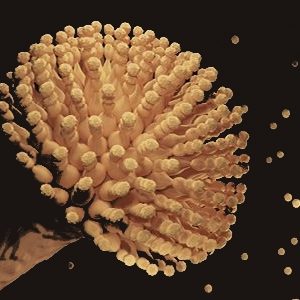What happens when people or cows are exposed to aflatoxins? What is the role of AFM1 in human aflatoxicosis? How can mycotoxin binders help to reduce the impact of aflatoxins? This article addresses these questions from a very practical point of view.
Introduction
When animals or people are offered food contaminated with aflatoxin, we are facing a major challenge to food safety: the occurrence of aflatoxicosis. Its course and severity depends on the dose ingested, the time of exposure, affected species, age of the animal, sexual cycle, nutritional state, etc.
The main target organs of aflatoxins are liver and kidney.
Their main toxic and carcinogenic effects are:
- Hepatotoxic, hepatocarcinogenic
- Neurotoxic
- Nephrotoxic
- Hemotoxic
- Enterotoxic
- Osteotoxic
- Immunosuppressive
Figure 1. Hepatic lesions associated with aflatoxicosis
The main observed signs are:
- Anorexia
- ↓ body weight
- ↓ productivity (eggs of milk)
- Haemorrhages
- Embryotoxicity
- ↓ reproductive performance
- ↑ susceptibility to diseases
What do we know about aflatoxicosis in cows?
We need to consider the following points to evaluate what we know and what we still need to learn about this problem. We know that:
- It is necessary to work with field data.
- Scientific literature is based on contamination levels that are much higher than the ones observed in the field. The dose-response curve is not linear.
- The effects of the concurrence of different mycotoxins has not yet been exhaustively studied.
- Do we obtain clear answers out of experimental work? The answer is no.
- The uncertainties around Aflatoxins results in decisions that are “arguable”.
- Feed contamination with aflatoxins produces delayed puberty in heifers.
- Mechanisms of excretion of Aflatoxin in ruminants are:
-
- Faeces: 55-80%
- Urine: 10-20%
- Meat: <1%
- Milk: 1-3%
-
The carryover rate of aflatoxin
Carryover rate of aflatoxin = Percentage of AFB1 excreted in milk as metabolite AFM1.
The carryover rate varies between 1-3% (min. 0,1% y max. 10%) and depends on:
- Animal species: dairy cow, dairy sheep, or dairy goat
- Productive level and days in production
- Somatic cells, due to membrane permeability (Masoero et al., 2017). These authors showed that cows with high somatic cell count (SCC) in milk had a higher amount of AFM1, compared to cows in similar production levels but lower SCC.
To counteract the effect of an AFB1 challenge at the farm and reduce the AFM1 carryover in milk, mycotoxin binders should be used.
What is a mycotoxin binder and what are their functions?
The Commission Regulation (EC) No. 386/2009, defines these additives as products that reduce mycotoxin contamination in animal feed by “suppressing or reducing the absorption, promoting the excretion of mycotoxins or modifying their mode of action”
A mycotoxin binder should:
- prevent or reduce the absorption of mycotoxins in the gastrointestinal tract.
- be free of impurities and odourless
- not modify nutrient availability
- have been evaluated in laboratory conditions and in the field.
Regulations in the European Union
Mycotoxin binders fall into the category 1m558, (Technological aditives) specified in Rules of Execution (UE) No. 160/2013. The only mechanism of action recognized in this document is “reducers of feed contamination by mycotoxins: aflatoxin B1”. It is specified that, in this category, the ONLY mycotoxin binder authorized in the EU is bentonite. This bentonite should fulfil very specific and restrictive conditions. Bentonites not achieving these criteria, are classified as additives 1m558i
Positive aspect of the use binders
- Reduced costs
- Quick binding mechanism
- Relatively easy evaluation of binding activity
- Easy to use at the farm and to include in the feed
- Little interference with heath status of animals
- Different approaches with diverse mechanism of action to increase efficacy (verify)
Negative aspects of the use of binders
- High cost (1-4% the cost of the ration).
- Little time to intervene.
- Evaluation requires in vitro screening tests (low cost), in vivo confirmation tests, or EXPERIENCE.
- Depending on the way the binder is used, its binding action improves or worsens.
- Possible side effects with prolonged use and/or high doses.
- Interfere with the analytical determination of Aflatoxins.
What should we do if we find AFM1 in milk?
Withdraw the feed from lactating cows and, if the feed is not excessively contaminated, recycle it giving it to heifers.
Take reliable samples and send them rapidly to the lab for analysis the objective is to know as soon as possible which one(s) is (are) the contaminated ingredient(s). Repidly analyse maize and other suspected ingredients with rapid tests (“immediate” response), and later confirm with HPLC.
If posible, treat the contaminated feed with a mycotoxin binder. Add 100-150 g (depending on the recommendation of the technical advisor) a binder of guaranteed efficacy (properly chosen). Wait for 1-4 milkings (depending on the initial level) before the milk can be consumed again.
- Treat the maize with binder (if possible)
- Sieve, areate and/or clean the grains, and/or reduce its inclussion with alternative ingredients (wheat, barley, sorghum)
Also analyse cotton, soya, and maize silage (acetone+HPLC tests)
Is cotton contaminated? Discard it
Is maize silage contaminated? Treat it witht toxin binder (if possible), and feed and/or replace it for other alternatives (pasture silage, cereal silages, etc.)
To remember:
- The main target organs of Aflatoxins are liver and kidneys.
- In-vitro experimental findings on aflatoxins need to be carefully extrapolated to field conditions
- Aflatoxin M1, metabolite of Aflatoxin B1, can pass to milk and enter the food chain.
- The carryover rate of aflatoxin is the propoertion of AFB1 that is excreted in milk as its metabolite AFM1.
- Toxin binders help to control the challenge of AFB1 and reduce the carryover of AFM1 in milk.
This article has previously published in agriNews Spanish version, as “De Aflatoxina B1 a Aflatoxina M1, ¿qué ocurre?“
